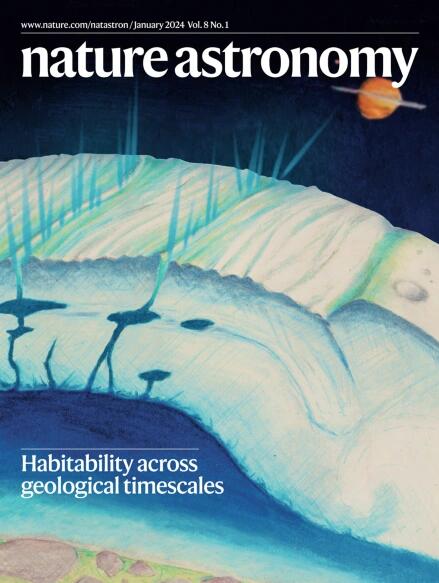Earth-mass planets with He atmospheres in the habitable zone of Sun-like stars
IF 14.3
1区 物理与天体物理
Q1 ASTRONOMY & ASTROPHYSICS
引用次数: 0
Abstract
The discovery of many low-mass exoplanets, including several planets within the habitable zone of their host stars, has led to the question of which kind of atmosphere surrounds them. Recent exoplanet detections have revealed the existence of a large population of low-mass planets (<3 M⊕) with H2-dominated atmospheres that must have been accreted from the protoplanetary disk. As the gas disk usually has an ~10% fraction of helium, we model the possible enrichment of the primordial He fraction in the atmosphere of planets with mass between 0.75 M⊕ and 3.0 M⊕ that orbit in the classical habitable zone of Sun-like stars. Depending on the mass accreted by the planet during the gas disk phase and the stellar high-energy flux between ~10 and 120 nm, we find that Earth-like planets with masses between ~0.95 M⊕ and 1.25 M⊕ inside the habitable zone of Sun-like stars can end up with He-dominated primordial atmospheres. This finding has important implications for the evolution of Earth-like habitats, as these thick helium-enriched primordial atmospheres can inhibit the habitability of these planets. The upcoming generation of giant telescopes, such as the Extremely Large Telescope, may enable us to observe and explore these atmospheres. Simulations of long-term atmospheric evolution show that rocky planets with Earth-like masses in the classical habitable zone of Sun-like stars can retain thick He-dominated primordial atmospheres.


地球质量的行星,在类太阳恒星的可居住区域有氦大气层
许多低质量系外行星的发现,包括几颗位于其主恒星宜居带内的行星,引发了围绕它们的是哪种大气的问题。最近的系外行星探测揭示了大量低质量行星(<3 M⊕)的存在,它们的大气以h2为主,一定是从原行星盘吸积而来的。由于气体盘通常含有~10%的氦,我们模拟了质量在0.75 M⊕至3.0 M⊕之间的行星在经典类太阳恒星宜居带轨道上的大气中可能富集的原始He分数。根据行星在气盘阶段的吸积质量和恒星在~10 ~ 120 nm之间的高能通量,我们发现在类太阳恒星的宜居带内,质量在~0.95 ~ 1.25 M⊕的类地行星最终可能形成以he为主的原始大气。这一发现对类地栖息地的进化具有重要意义,因为这些富含氦的厚重原始大气可以抑制这些行星的可居住性。即将到来的一代巨型望远镜,如超大型望远镜,可能使我们能够观察和探索这些大气。
本文章由计算机程序翻译,如有差异,请以英文原文为准。
求助全文
约1分钟内获得全文
求助全文
来源期刊

Nature Astronomy
Physics and Astronomy-Astronomy and Astrophysics
CiteScore
19.50
自引率
2.80%
发文量
252
期刊介绍:
Nature Astronomy, the oldest science, has played a significant role in the history of Nature. Throughout the years, pioneering discoveries such as the first quasar, exoplanet, and understanding of spiral nebulae have been reported in the journal. With the introduction of Nature Astronomy, the field now receives expanded coverage, welcoming research in astronomy, astrophysics, and planetary science. The primary objective is to encourage closer collaboration among researchers in these related areas.
Similar to other journals under the Nature brand, Nature Astronomy boasts a devoted team of professional editors, ensuring fairness and rigorous peer-review processes. The journal maintains high standards in copy-editing and production, ensuring timely publication and editorial independence.
In addition to original research, Nature Astronomy publishes a wide range of content, including Comments, Reviews, News and Views, Features, and Correspondence. This diverse collection covers various disciplines within astronomy and includes contributions from a diverse range of voices.
 求助内容:
求助内容: 应助结果提醒方式:
应助结果提醒方式:


